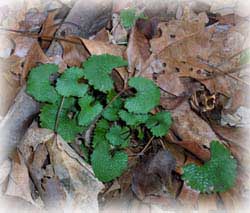Spring Wildflowers
Spring ephemerals and what they can tell you about a forest.Spring ephemerals are wildflowers which appear in the early spring, before the trees have come out of their winter dormancy. These plants take advantage of the light conditions to sprinkle the woodlands with patches of color. By the end of May or early June, most of these wildlowers have finished their life for the season and die back, awaiting next spring.
 Our earliest spring wildflower: Skunk Cabbage.
Our earliest spring wildflower: Skunk Cabbage.
A number of these wildflowers are good indicators of the ecological conditions present in the forest. For example, Large white-flowered trillium (Trillium grandiflorum) is sensitive to deer browsing. If an area has a high deer population and there are trillium present, a large percentage of the trillium will not produce flowers, since their below ground energy storage has been depleted deer eating the above ground poirtion of the plants several years in a row.
 A non-native wildflower, Garlic Mustard.
A non-native wildflower, Garlic Mustard.
The disturbance history of a forest may be hinted at by the diversity of wildflowers as well. When a forest is disturbed, be it grazing, row crops or otherwise, it takes time for native plant communities to re-establish. If there are many species of wildflowers in a forest, chances are the forest has been undisturbed for longer than a forest with significantly fewer native wildflowers. Non-native plants such as garlic mustard (Alliaria petiolata, pictured at the right) are also wildflowers, albeit unwanted ones. They tend to grow in these disturbed areas, crowding out native wildflowers. When you find such plants, look around and see if you can identify the reason they are present.
The wildflowers you find will give many clues about the forest. Learn the habitat requirements of plants, and you will be able to sleuth out the secrets of your favorite forest in no time. For example, Skunk cabbage (Symplocarpus foetidus, pictured at the left) grows only near seeps or wetlands, so if you find it, you know the ground is moist most of the year. Other plants that indicate wetlands are marsh marigold (Caltha palustris), cat-tails (Typha spp.), and sedges (carex spp.).
